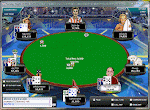When I'm not out playing live, my favorite online game is the Heads Up Tourneys on Full Tilt. At the moment, I am playing the N/L Hold 'Em and Stud H/L varieties almost exclusively. I have developed a strategy that seems to work well when it comes to decisions in potential coin flip situations.
As any of you who have played these tournaments have probably noticed, there is a particular set of players that enjoy pushing all in on a semi-frequent basis after the pot has been raised pre-flop. It typically goes something like this (for me.) I will triple the big blind (often with a hand like A-8, KQ, JQ, 55, you get the idea) and then someone will push all in over top of me. What to do? Well the answer depends on a couple of factors. First, let's assume that the villain is not doing this ALL the time. There are players who will raise all in anytime you raise or (in extreme cases) every pre-flop. I deal with them a little differently, so for the sake of this evaluation we will assume that villain is not raising all in all the time, but just occasionally or even semi-frequently.
The first thing that I evaluate when deciding whether to call all my chips into the middle is the skill level of the person I am playing. At the limits that I play, I feel that I am definitely the dominant player 95% of the time. Therefore, I believe that I can grind the other player down and I don't need to try for coin flips. Because of this, I will usually fold anything but Qs, Ks, or As pre-flop in this situation. Now, obviously, the more often someone is making this move, the more lenient you need to become with the hands you are willing to call. If it starts happening more frequently, I will sometimes add AK or AQ to the mix of hands I am willing to get all my chips in with. Another way to adjust to many of these maniacs is to start playing small pot poker. Stop raising with your big hands pre-flop and try to win in unraised pots. It takes longer to finish the match, but if you are the superior post-flop player it should not be a problem.
My strategy begins to change as the limits go up. If you get to the 60/120 blind level and above, and you still have not vanquished your opponent, you can no longer afford to pass up solid opportunities to secure the win. You then must consider getting all your chips in the middle with progressively less spectacular hands. I also adjust my requirements substantially when I feel that I am facing a tough opponent. I played a tournament last night against a player that was surprisingly good. I had what I felt would be a coin flip situation in the 40/80 blind level when I held AJ suited and I took it. He had pocket 9s and I lost, but I felt ok about the decision because I was a little low on chips and I was facing an opponent that was not easily dominated. I did come back and beat him in a re-match.
Well that's it from the virtual felt today. Good luck and may all your cards be live!
Subscribe to:
Post Comments (Atom)




No comments:
Post a Comment